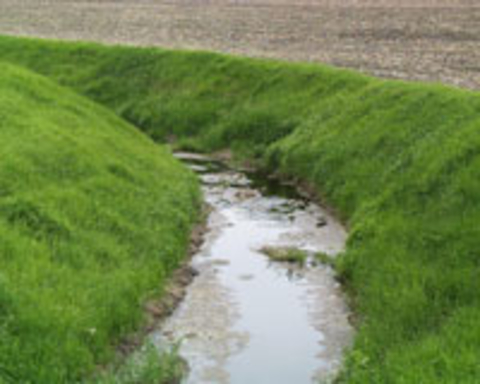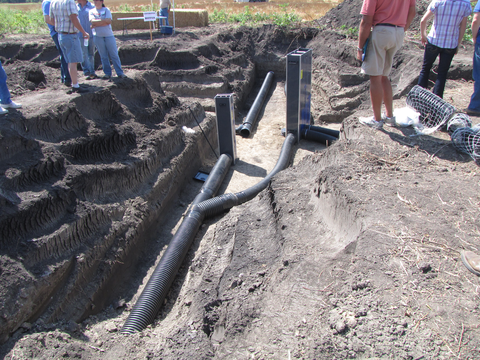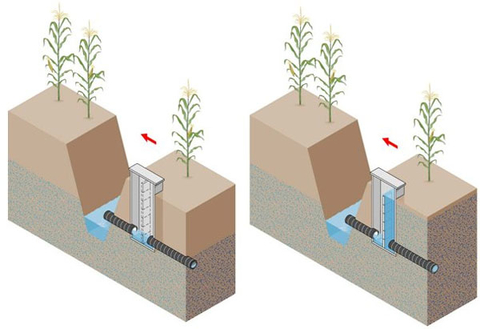Glacial processes in the Upper Midwest created an abundance of highly productive but poorly drained soils. While it’s improved agricultural production, drainage also affects hydrology, water quality and wetland habitats.
Improved agricultural production
Poorly drained soils increase risks to agricultural production from excess water and high water tables. Proper soil drainage improves agricultural production by:
-
Ensuring timely planting and field operations.
-
Minimizing soil compaction and salt buildup.
-
Promoting conditions for good seedbed establishment and germination.
-
Minimizing high water table stresses to growing crops.
-
Outyielding poorly drained soils
-
Offering less year-to-year yield variability.
-
Improving the opportunity to employ other conservation practices such as minimum tillage.
Other effects
Both artificial drainage and land-use change (prairie to agriculture) affect hydrology, water quality and habitat. It’s difficult to separate the individual effects of drainage and land-use change.
Hydrology
Surface and subsurface drainage have very different hydrologic impacts.
-
Surface drainage speeds flow from the landscape and increases peak flows.
-
Tile drainage promotes more infiltration, slowing water delivery from the landscape (compared to surface drainage). However, studies indicate the potential for overall water yield increases from 5 to 10 percent.
Local hydrologic effects are dampened at larger watershed scales.
Water quality
Surface and subsurface drainage affect water quality differently:
-
Surface drainage may increase losses from surface runoff (primarily sediment and phosphorus).
-
Tile drainage may reduce surface runoff pollutants, but may increase dissolved nutrients such as nitrate.
Wetland reductions
Drainage activities have reduced the number and extent of wetlands. In some areas, they’ve reduced by as much as 90 percent.
However, wetlands are now protected by federal and state laws. In some areas, wetlands are actually being restored, usually on land that once was cultivated.
Drainage usage
Crop producers’ primary artificial drainage practices are surface drainage (ditches) and subsurface (tile) drainage.
Subsurface drainage began in Upstate New York, at Johnston Farm, in the 1830s. Today, approximately 25 percent of U.S. arable land employs either or both surface or subsurface drainage.
-
The earliest drainage activities in the region addressed agriculture, transportation infrastructure and human health needs.
-
The percentage of tile-drained land in Minnesota widely varies, but perhaps 20 to 30 percent of the agricultural soils in the Minnesota River Basin are tile-drained. In some locations, higher percentages exist (Figure 2).
-
Minnesota farmers can drain their lands, provided they have an outlet and comply with Department of Agriculture and state wetland regulations (Figure 3).
-
Current drainage activity in the Midwest typically replaces older, less effective drainage systems with new systems. In these new systems, it’s important to incorporate technologies to reduce environmental concerns (Figure 4).
Conservation drainage practices
It’s important to meet water quality goals while addressing drainage needs for agriculture. Consider incorporating one or more of these conservation practices:
-
Nutrient best management practices
-
Controlled drainage or drainage water management (Figure 5)
-
Two-stage ditches
-
Shallow drainage
-
Reduce drainage intensity
-
Woodchip bioreactors
-
Improved surface inlets
-
Improved side inlets
-
Winter cover crops
-
Wetland restoration
-
Nutrient retention basins
Drainage water management design (Figures 6 and 7) calls for dividing the field into water control/management zones, aligning laterals with the field contours and using control structures. Annual subsurface flow and nitrate reductions of 10 to 50 percent may be possible.
Blann, K., Anderson, J.L., Sands, G., & Vondracek, B. (2009). Effects of agricultural drainage on aquatic ecosystems: A review. Critical Reviews in Environmental Science and Technology, 39(11), 909-1001.
Frankenberger, J., Kladivko, E., Sands, G., Jaynes, D., Fausey, N., Helmers, M., Cooke, R., Strock, J., Nelson, K., & Brown, L. (2006). Drainage water management for the Midwest: Questions and answers about drainage water management for the Midwest (Purdue Extension Publication WQ-44).
Skaggs, R.W., Breve, M.A., & Gilliam, J.W. (1994). Hydrologic and water quality impacts of agricultural drainage. Critical Reviews in Environmental Science and Technology, 24, 1-32.
Moore, I.D. & Larson, C. (1979). Effects of drainage projects on surface runoff from small depressional watersheds in the north central region (WRRC Bulletin 99).
Robinson, M. & Rycroft, D. (1999). The impact of drainage on stream flows. In Agricultural Drainage (Monograph number 38, 767-800). ASA-SSSA-CSSA.
Sands, G.R., Song, I., Busman, L.M., & Hansen, B. (2008). The effects of subsurface drainage depth and intensity on nitrate load in a cold climate. Transactions of the ASABE, 51(3), 937-946.
Dinnes, D.L., Karlen, D.L., Jaynes, D.B., Kaspar, T.C., Hatfield, J.L., Colvin, T.S., & Cambardella, C.A. (2002). Nitrogen management strategies to reduce nitrate leaching in tile drained Midwestern soils. Agronomy Journal, 94(1), 53-171.
Skaggs, R.W., Youssef, M.A., Chescheir, G.M., & Gilliam, J.W. (2005). Effects of drainage intensity on nitrate losses from drained lands. Transactions of the ASABE, 48(6), 2169-2177.
Thorp, K.R., Jaynes, D.B., & Malone, R.W. (2008). Simulating the long-term performance of drainage water management across the Midwestern United States. Transactions of the ASABE, 51(3), 961-976.
Reviewed in 2018








